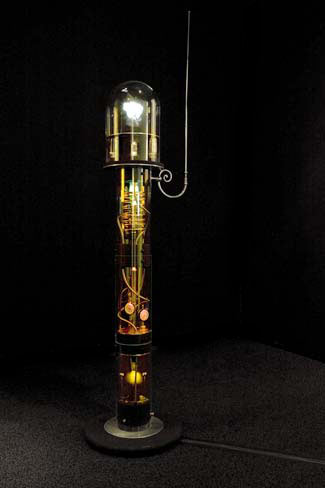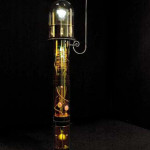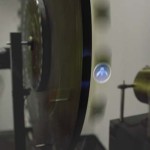By MATTHEW NASH
Thomas Edison’s landmark 1903 film “The Great Train Robbery” ends with a famous shot of a bandit firing his gun at the camera. Wikipedia notes that “(a)udiences at the time, for whom moving pictures were still very new and unfathomable, would usually scream in fear, then laugh in relief.”
There was once a wonder about moving images, and a fascination created by the artificial re-creation of life through the flickering projections of light on a screen, or of static images viewed through the spinning slits of an kinetoscope, or the flip-card titillation of a penny picture show. Watching images move was a novelty, wrapped up in the larger marvel of the industrial revolution, and inextricably linked to the technology of display. One hundred and four years after Edisons Train Robbery, moving pictures are ubiquitous, carried via television, theatre and the internet in vast quantities and at all hours. The marvel of Edison’s film has been lost, the reverence for the technology of display has faded, and our acceptance of the content has become jaded.
This, it seems, is the very subject of “Picture Show” at the Photographic Resource Center. Each work strives to re-create the magic of those early moments, and invent new experiences for audiences who are not generally fascinated by moving pictures.
The success of much of the show, it seems, lies not in fact that the images move, but the various forms of devices that make up the picture show. Steven Hollinger and Deb Todd Wheeler, in particular, go to great lengths to remind us of the tools they are using and how simple it can be to fascinate and amaze. All of the artists push the extremes of making something old new again, and then filter these updated perceptions through a contemporary lens. These are picture shows as they might have functioned mechanically a century ago, but they are conceptually very current.
Erica Von Schilgen’s mechanical collages are probably the most straight-forward works in the show, at least as they function as moving images. Each piece is a vitrine of collaged characters that move when the viewer turns a crank at the top of the piece, raising or lowering wires and chains that animate the figures. In Mon Petite Espace, numerous child-like figures are encased in their own small boxes, calling to mind Joseph Cornell’s boxes. The little figures are hinged at the joints and move, as if dancing, when one turns the gears.
Von Schilgen’s moving images are openly mechanical, and their gears and strings are part of the charm. In many ways, it is her work that represents the 19th century picture show and, of the artists in the show, she reaches the furthest back into history for her inspiration. That her mechanisms are made visible, and it is so easy to understand her methods, her pieces remind us of how much our relationship to wonder has been changed by the post-industrial era.
If one considers the artists “Picture Show” in relation to Edison, Von Schilgen reminds us of the theatricality of entertainment prior to him; Deb Todd Wheeler, Olivia Robinson and Steve Hollinger each reconsider and build from his history.
Deb Todd Wheeler presents two pieces that explore the motion implicit in creating a moving image. One piece requires the motion of the viewer, via a crank, which generates the power to display her images. Her other work, Ludicrum: naturalia, artificialia, scientific v.4, creates a whimsical moving image that appears to float in mid-air.
Like Von Schilgen’s mechanical vitrines, Wheeler’s Ludicrum does not hide its mechanisms. The piece is a mounted wheel, studded with circular discs that each contain a single image. When a viewer spins the wheel, the power generated by the motion triggers a flickering light that illuminates a single image at a time, and creates a floating movement.
Steve Hollinger’s machinery may be a little more hidden, but his pieces reveal enough of their methods to remain intriguing as both moving images and technology. The most notable of his works presents a box topped with an angled piece of glass that, when viewed from the proper kneeling position, shows a moving image created by a spinning disc of small images, not unlike a Coney Island arcade show from a time past.
Of all the works in Picture Show, Hollinger’s relate most directly to the evolution of cinema and the picture shows of the past. Each is an updated version of an historical moment, bringing the devices of a time prior to the ubiquity of cathode ray tubes to our current era. Returning to the idea of a relationship to Edison, Hollinger seems to hope for the possibilities of the alternatives, and his pieces explore the various avenues that were abandoned long ago.
Olivia Robinson’s pieces, in contrast, are wholly contemporary. They make use of elements that are decisively modern, altered as they may be, and equally loaded with nostalgic implications. Inside & Out presents a sphere that is housed in a knitted shell, with a digital display along one side. Holding the piece, or giving it a shake, causes the image on the screen to adjust, change, and reset itself in response to the viewer. In many ways, Inside & Out feels like a cross between a Magic 8-Ball and a Wii.
The fifth artist of “Picture Show” cannot be considered against Thomas Edison: the references predate Menlo Park by many years.The Dream Of Timmy Bumble Bee, on loan from the Musée Patamécanique, is an updated version of a piece found in that museum, and it should be considered against the intentions and ideology of that institution.
Le Museée Patamécanique is “a re-introduction to that wonderful sense of the marvelous, the magical, and the sublime that existed before the demise of the historic Cabinets of Curiosities.” Its role is to present artifacts that validate an existence or realm “supplementary to this one; or, less ambitiously, will describe a universe which can be – and perhaps should be – envisaged in the place of the traditional one.”
“The Dream Of Timmy Bumble Bee,” as found at Musée Patamécanique, features the carcasses of seven bumble bees, connected by electric wires, to glass jars with bees of light fluttering inside. Their story is told in a poem that begins:
T’was in the prime of summer,
On a morning calm and cool,
That seven buzzing bumble bees
Were on their way to school.
They skipped across the dew dropped-leaves,
Like wavelets upon a pool.
This poem is presented on the wall of the PRC beside the updated Timmy Bumble Bee piece: a glass column of devices and activity, bubbling liquids and spinning dials, twisting gears and whirring motors. At the top of this rests a glass bell jar, containing a single fluttering bee: Timmy.
The PRC has taken special care to place this piece at the back of the gallery, separated from the other works by a wall. It comes to life when one enters the space, as if it is the special prize saved for the end of the tour, a wonder above the other wonders in this already fantastic show.
“Picture Show” is just what is needed within the vast spectacle that is the Boston Cyberarts Festival. Surrounded by tons of great work that celebrates our great achievements with technology, the PRC has offered us a reminder of a time when there was great wonder to be found in the simple movement of an image.
- Hans Spinnerman, The Dream Of Timmy Bumble Bee, 2007.
- Deb Todd Wheeler, Ludicrum: naturalia, artificialia, scientific v.4, 2007.
- Olivia Robinson, Inside & Out.
Photographic Resource Center
Musée Patamécanique
"Picture Show" is on view March 30 - May 6, 2007 at the Photographic Resource Center.
All images are courtesy of the artists and the PRC.
Photos by Jeremias Paul.







